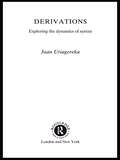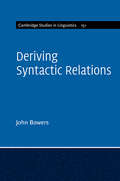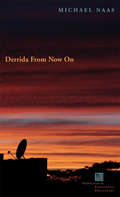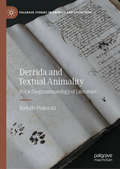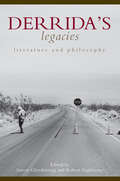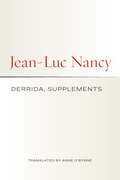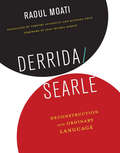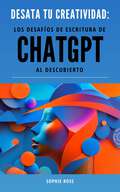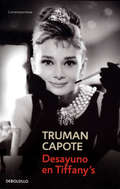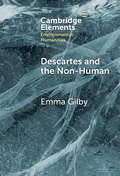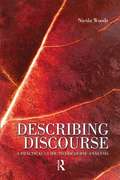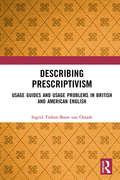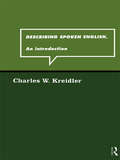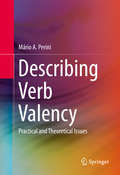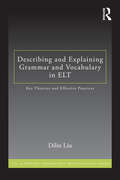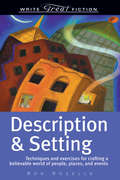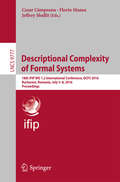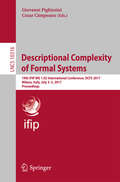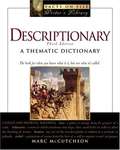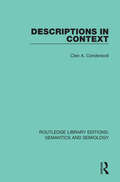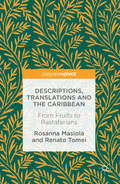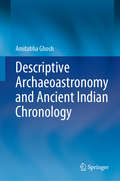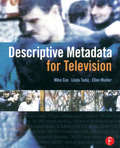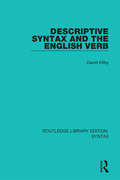- Table View
- List View
Derivations: Exploring the Dynamics of Syntax (Routledge Leading Linguists)
by Juan UriagerekaDerivations draws together some of the most influential work of one of the world's leading syntactitians, Juan Uriagekera. These essays provide several empirical analyses and technical solutions within the Minimalist Program. The book persues a naturalistic take on Minimalism, explicitly connecting a variety of linguistic principles and conditions to arguably analogous laws and circumstances in nature.
Deriving Syntactic Relations (Cambridge Studies In Linguistics #151)
by John BowersA pioneering new approach to a long-debated topic at the heart of syntax: what are the primitive concepts and operations of syntax? This book argues, appealing in part to the logic of Chomsky's Minimalist Program, that the primitive operations of syntax form relations between words rather than combining words to form constituents. <P><P>Just three basic relations, definable in terms of inherent selection properties of words, are required in natural language syntax: projection, argument selection, and modification. In the radically simplified account of generative grammar Bowers proposes there are just two interface levels, which interact with our conceptual and sensory systems, and a lexicon from which an infinite number of sentences can be constructed. The theory also provides a natural interpretation of phase theory, enabling a better formulation of many island constraints, as well as providing the basis for a unified approach to ellipsis phenomena.<P> Simplifies syntactic theory by eliminating a redundant and unnecessary layer of syntactic structure.<P> Derives sentence structure from combinations of just three basic relations, thus reducing to a bare minimum the primitive nature of syntactic theory.<P> Predicts the range of cross-linguistic word order variation by means of a simple, incremental spell-out operation, along with language-specific directionality parameters.
Derrida From Now On (Perspectives in Continental Philosophy)
by Michael NaasWritten in the wake of Jacques Derrida's death in 2004, Derrida From Now On attempts both to do justice to the memory of Derrida and to demonstrate the continuing significance of his work for contemporary philosophy and literary theory. If Derrida's thought is to remain relevant for us today, it must be at once understood in its original context and uprooted and transplanted elsewhere. Michael Naas thus begins with an analysis of Derrida's attachment to the French language, to Europe, and to European secular thought, before turning to Derrida's long engagement with the American context and to the ways in which deconstruction allows us to rethink the history, identity, and promise of post-9/11 America. Taking as its point of departure several of Derrida's later works (from "Faith and Knowledge" and The Work of Mourning to Rogues and Learning to Live Finally), the book demonstrates how Derrida's analyses of the phantasms of sovereignty, the essential autoimmunity of democracy or religion, or the impossible mourning of the nation-state can help us to understand what is happening today in American culture, literature, and politics. Though Derrida's thought has always lived on only by being translated elsewhere, his disappearance will have driven home this necessity with a new force and an unprecedented urgency. Derrida From Now On is an effect of this force and an attempt to respond to this urgency.
Derrida and Textual Animality: For a Zoogrammatology of Literature (Palgrave Studies in Animals and Literature)
by Rodolfo PiskorskiDerrida and Textual Animality: For a Zoogrammatology of Literature analyses what has come to be known, in the Humanities, as ‘the question of the animal’, in relation to literary texts. Rodolfo Piskorski intervenes in the current debate regarding the non-human and its representation in literature, resisting popular materialist methodological approaches in the field by revisiting and revitalising the post-structuralist thought of Derrida and the ‘linguistic turn’. The book focuses on Derrida’s early work in order to frame deconstructive approaches to literature as necessary for a theory and practice of literary criticism that addresses the question of the animal, arguing that texts are like animals, and animals are like texts. While Derrida’s late writings have been embraced by animal studies scholars due to its overt focus on animality, ethics, and the non-human, Piskorski demonstrates the additional value of these early Derridean texts for the field of literary animal studies by proposing detailed zoogrammatological readings of texts by Freud, Clarice Lispector, Ted Hughes, and Darren Aronofsky, while in dialogue with thinkers such as Butler, Kristeva, Genette, Deleuze and Guattari, and Attridge.
Derrida's Legacies: Literature and Philosophy
by Robert Eaglestone Simon GlendinningThis volume brings together some of the most well-known and highly respected commentators on the work of Jacques Derrida from Britain and America in a series of essays written to commemorate the life and come to terms with the death of one of the most important intellectual presences of our time. Derrida’s thought reached into nearly every corner of contemporary intellectual culture and the difference he has made is incalculable. He was indeed controversial but the astonishing originality of his work, always marked by the care, precision and respect with which he read the work of others, leaves us with a philosophical, ethical and political legacy that will be both lasting and decisive. The sometimes personal, always insightful essays reflect on the multiple ways in which Derrida’s work has marked intellectual culture in general and the literary and philosophical culture of Britain and America in particular. The outstanding contributors offer an interdisciplinary view, investigating areas such as deconstruction, ethics, time, irony, technology, location and truth. This book provides a rich and faithful context for thinking about the significance of Derrida’s own work as an event that arrived and perhaps still remains to arrive in our time. Contributors: Derek Attridge, Thomas Baldwin, Geoffrey Bennington, Rachel Bowlby, Alex Callinicos, David E. Cooper, Simon Critchley, Robert Eaglestone, Simon Glendinning, Marian Hobson, Christopher Johnson, Peggy Kamuf, Michael Naas, Nicholas Royle
Derrida, Supplements
by Jean-Luc NancyWhen Jean-Luc Nancy first encountered the work of Jacques Derrida in the 1960s, he knew he was hearing something new, a voice genuinely of its time. Thinking with and against each other over the course of their long friendship, the two thinkers reshaped the European intellectual landscape. Nancy’s writings on Derrida, collected in this volume, reflect on the elements of their shared concerns with politics, the arts, religion, the fate of deconstruction, and the future of sense. Rather than studies, commentaries, or interpretations of Derrida’s thought, they are responses to his presence—not exactly a presence to self, but a presence in the world.
Derrida/Searle: Deconstruction and Ordinary Language
by Raoul MoatiRaoul Moati intervenes in the critical debate that divided two prominent philosophers in the mid-twentieth century. In the 1950s, the British philosopher J. L. Austin advanced a theory of speech acts, or the "performative," that Jacques Derrida and John R. Searle interpreted in fundamentally different ways. Their disagreement centered on the issue of intentionality, which Derrida understood phenomenologically and Searle read pragmatically. The controversy had profound implications for the development of contemporary philosophy, which, Moati argues, can profit greatly by returning to this classic debate. In this book, Moati systematically replays the historical encounter between Austin, Derrida, and Searle and the disruption that caused the lasting break between Anglo-American language philosophy and continental traditions of phenomenology and its deconstruction. The key issue, Moati argues, is not whether "intentionality," a concept derived from Husserl's phenomenology, can or cannot be linked to Austin's speech-acts as defined in his groundbreaking How to Do Things with Words, but rather the emphasis Searle placed on the performativity and determined pragmatic values of Austin's speech-acts, whereas Derrida insisted on the trace of writing behind every act of speech and the iterability of signs in different contexts.
Desata tu creatividad: los desafíos de escritura de ChatGPT al descubierto
by Sophie RossDa rienda suelta a tu creatividad con el poder de la inteligencia artificial en «Desata tu creatividad: los desafíos de escritura de ChatGPT al descubierto». Esta completa guía ofrece una perspectiva única sobre el uso de ChatGPT de OpenAI para mejorar tu proceso de escritura, y te proporciona una gran variedad de consejos prácticos y propuestas generados por la IA para escritores de todos los niveles. Desde la exploración de distintos géneros de escritura hasta la creación de personajes y tramas cautivadores, este libro lo abarca todo. Aprende a superar el bloqueo del escritor con estrategias innovadoras y utiliza la IA para reavivar tu chispa creativa. Descubre cómo afinar las respuestas de ChatGPT, adaptar los estímulos a tu voz personal y combinar estímulos para enriquecer la escritura. El libro también hace hincapié en la importancia de las comunidades de escritores y de compartir tu trabajo, con ideas para aprender de las experiencias de los demás con ChatGPT. Tanto si eres un escritor experimentado en busca de nueva inspiración como un principiante que explora el ámbito de la escritura creativa, «Desata tu creatividad: los desafíos de escritura de ChatGPT al descubierto» es tu guía. Embárcate en este viaje y deja que la IA transforme tu proceso de escritura para siempre.
Desayuno en Tiffany
by Truman Capote"No entregues nunca tu corazón a un ser salvaje porque, si lo haces, se vuelve más y más fuerte hasta que adquiere la fuerza suficiente para volver al bosque o volar hacia un árbol. Y luego, a otro más alto hasta que desaparece en el cielo."Holly Golightly es, tal vez, el personaje más cautivante creado por Truman Capote. Atractiva sin ser linda, tras haber rechazado una carrera de actriz en Hollywood se convierte en una de las figuras de la Nueva York más sofisticada, tomando cócteles por las noches, saliendo con hombres adinerados y rompiendo corazones. Mezcla de picardía e inocencia, de astucia y autenticidad, Holly se contenta con vivir el presente, sin mencionar su pasado y sin aferrarse a nada ni a nadie. Pero, pese al glamour que la rodea, soñando siempre con ese paraíso de lujo que representa la joyería Tiffany, de a poco revela una personalidad mucho menos resplandeciente.
Descartes and the Non-Human (Elements in Environmental Humanities)
by Emma GilbyDescartes features heavily in ecocritical literature. He is often said to dismiss the non-human world as irrelevant and inanimate, and to espouse a harmfully instrumental attitude towards it. This Element goes into detail on the standard picture in circulation, while also outlining an alternative approach that it terms 'ecohistorical'. It aims to offer insights into the seventeenth-century context; and to explain in clear terms what Descartes said, what problems emerge with his account, and why a more precise understanding of these problems can be useful today. Reconsidering Descartes in this light involves extending prior arguments about his treatment of animals to a study of the natural world in general. Early modern narratives about the world's living networks are complex and interesting. When locally salient artefacts, attitudes, ideas, and vocabulary are highlighted, a more nuanced picture emerges, changing the relevance of Descartes for environmental thinking.
Descolonizar la mente: La política lingüística de la literatura africana
by Ngugi wa Thiong'oUn compendio de los temas centrales de la obra del autor: la confrontación entre el neocolonialismo y la clase trabajadora, y su reflejo en la cultura africana. Descolonizar la mente es una referencia ineludible en el debate lingüístico que tiene lugar en el marco de los estudios poscoloniales. Reúne cuatro conferencias que el autor realizó entre 1981 y 1985, cuyo hilo conductor no es solo una reflexión sobre el papel de la lengua en la construcción de la identidad nacional, cultural, social e histórica, y su función en la descolonización, sino también sobre los acontecimientos vitales que han contribuido a elaborar el pensamiento del autor. En última instancia, Ngugi wa Thiong'o -escritor, pensador, humanista y exiliado- concibe este libro como una declaración de intenciones: en la medida en que la lengua materna es un aspecto crucial de la propia identidad, cree necesario despedirse del inglés y utilizar el kikuyu como su principal lengua de creación literaria. La presente edición contiene un prólogo de Marta Sofía López Rodríguez, reputada especialista en literatura africana y estudios postcoloniales. La crítica ha dicho...«Un clásico controvertido.»Gayatri Spivak «Ngugi es el escritor africano más célebre. Ofrece ni más ni menos que un nuevo camino para la literatura africana.»British Book News «En la cima de sus logros como artista de gran imaginación, la decisión del autor keniano de escribir en kikuyu es realmente valiente.»The Guardian
Describing Discourse: A Practical Guide to Discourse Analysis
by Nicola WoodsFor anyone approaching Discourse Analysis for the first time, theory means little when it is not related to actual knowledge and experience of language in use. Describing Discourse takes the unique approach of introducing discourse studies through the hands-on analysis of linguistic data. The book introduces students to specific discourses constructed for particular purposes, for example, from the domains of advertising, law, medicine and education. Each chapter provides examples, exercises and commentary designed to develop the analytical abilities needed in describing the characteristic forms and typical functions of different discourses. Describing Discourse provides the ideal entry into the study of discourse for students new to the subject.
Describing Prescriptivism: Usage guides and usage problems in British and American English
by Ingrid Tieken-Boon van OstadeDescribing Prescriptivism provides a topical and thought-provoking analysis of linguistic prescriptivism in British and American English, from a historical as well as present-day perspective. Focusing on usage guides and usage problems, the book takes a three-fold approach to present an in-depth analysis of the topic, featuring: a detailed study of the advice provided in usage guides over the years; an authoritative comparison of this advice with actual usage as recorded in British and American corpora, including the HUGE (Hyper Usage Guide of English) database – developed specifically to enable this line of study – as well as more mainstream corpora such as COCA, COHA and the BNC; a close analysis of the attitudes to particular usage problems among the general public, based on surveys distributed online through the "Bridging the Unbridgeable" research project’s blog.* With extensive case studies to illustrate and support claims throughout, this comprehensive study is key reading for students and researchers of prescriptivism, the history of English and sociolinguistics. *Found at https://bridgingtheunbridgeable.com/
Describing Spoken English: An Introduction
by Charles W. KreidlerDescribing Spoken English provides a practical and descriptive introduction to the pronunciation of contemporary English. It presumes no prior knowledge of phonetics and phonology.Charles Kreidler describes the principal varieties of English in the world today. Whilst concentrating on the phonological elements they share, the author sets out specific differences as minor variations on a theme. Although theoretically orientated towards generative phonology, theory is minimal and the book is clear, comprehensive and accessible to undergraduate and postgraduate students of linguistics and English Language. Numerous exercises are included to encourage further study.
Describing Verb Valency
by Mário Alberto PeriniThe elaboration of linguistic theories depends on the existence of adequate descriptions of particular languages; otherwise theories will be poorly grounded on empirical data. This book starts from theoretical points of wide acceptance among linguists and goes on to present a descriptive metalanguage, able to express the facts of verb valency, which constitute one of the core areas in linguistic description. Most of the data come from an extensive survey under way of the valency of Portuguese verbs; but the present work's relevance goes well beyond that, and incorporates a proposal applicable to other European languages, illustrated by the wealth of English examples included in the exposition. Among the topics discussed are the syntactic component of constructions (following here a proposal recently published in Culicover and Jackendoff's Simpler Syntax); delimitation and definition of semantic roles; the role of linking rules and their relation to prototypes; and the connection between linguistic expressions and cognitive units such as frames and schemata. The result is a notational system flexible and robust enough to describe all aspects of verb valency.
Describing and Explaining Grammar and Vocabulary in ELT: Key Theories and Effective Practices (ESL & Applied Linguistics Professional Series)
by Dilin LiuLanguage description plays an important role in language learning/teaching because it often determines what specific language forms, features, and usages are taught and how. A good understanding of language description is vital for language teachers and material writers and should constitute an important part of their knowledge. This book provides a balanced treatment of both theory and practice. It focuses on some of the most important and challenging grammar and vocabulary usage questions. Using these questions as examples, it shows how theory can inform practice and how grammar and vocabulary description and explanation can be made more effective and engaging. Part I describes and evaluates the key linguistic theories on language description and teaching. Part II discusses and gives specific examples of how challenging grammar and vocabulary issues can be more effectively described and explained; each chapter focuses on one or more specific grammar and vocabulary. An annotated list of useful free online resources (online corpora and websites) for grammar and vocabulary learning and teaching, and a glossary provide helpful information.
Description & Setting (Write Great Fiction)
by Ron RozelleShows writers how to master the challenging and often overlooked subjects of description and setting, offering hands-on action-and-results exercises.
Descriptional Complexity of Formal Systems
by Jeffrey Shallit Florin Manea Cezar CâmpeanuThis book constitutes the refereed proceedings of the 17th International Conference on Descriptional Complexity of Formal Systems, DCFS 2015, held in Waterloo, ON, Canada, in June 2015. The 23 full papers presented together with 2 invited talks were carefully reviewed and selected from 29 submissions. The subject of the workshop was descriptional complexity. Roughly speaking, this field is concerned with the size of objects in various mathematical models of computation, such as finite automata, pushdown automata, and Turing machines. Descriptional complexity serves as a theoretical representation of physical realizations, such as the engineering complexity of computer software and hardware. It also models similar complexity phenomena in other areas of computer science, including unconventional computing and bioinformatics.
Descriptional Complexity of Formal Systems
by Cezar Câmpeanu Giovanni PighizziniThis book constitutes the refereed proceedings of the 13th International Workshop of Descriptional Complexity of Formal Systems 2011, held in Limburg, Germany, in July 2011. The 21 revised full papers presented together with 4 invited papers were carefully reviewed and selected from 54 submissions. The topics covered are automata, grammars, languages and related systems, various measures and modes of operations (e. g. , determinism and nondeterminism); trade-offs between computational models and/or operations; succinctness of description of (finite) objects; state explosion-like phenomena; circuit complexity of Boolean functions and related measures; resource-bounded or structure-bounded environments; frontiers between decidability and undecidability; universality and reversibility; structural complexity; formal systems for applications (e. g. , software reliability, software and hardware testing, modeling of natural languages); nature-motivated (bio-inspired) architectures and unconventional models of computing; Kolmogorov complexity.
Descriptionary (3rd edition)
by Marc MccutcheonAre you exerting your corrugator overmuch trying to remember what to call more than one ferret? This combination of a reverse dictionary and thesaurus groups terms by basic themes, making it easy to find that ferrets in a communal situation constitute a "business." The groups include animals, architecture, clothing, electronics, finance, the human body, language, medicine, the military, music, performing arts, the physical sciences, religion, sports, tools, transportation, and weapons, with categories such as British terms, Internet chatting, and street slang added for this edition. The book is rounded out with an index that helps readers locate words they think they might know, and a list of words and expressions that they really should know. Annotation ©2004 Book News, Inc., Portland, OR (booknews.com)
Descriptions in Context (Routledge Library Editions: Semantics and Semiology #4)
by Cleo A. CondoravdiFirst published in 1997, this book focuses on the semantics of definite and indefinite descriptions — taking the presuppositional theory of definiteness and indefiniteness proposed by Heim as a starting point. It seeks to show that there exists a special type of indefinites that have an interpretation commonly associated with definites. It further argues that the felicity conditions associated with indefinite NP’s can vary and develops a more fine-grained theory of novelty within the framework of File Change Semantics. More generally, this work can be seen as providing an empirical argument in favour of a dynamic theory of meaning and against the more traditional truth-conditional theory.
Descriptions, Translations and the Caribbean
by Rosanna Masiola Renato TomeiThis book offers a new perspective on the role played by colonial descriptions and translation of Caribbean plants in representations of Caribbean culture. Through thorough examination of Caribbean phytonyms in lexicography, colonization, history, songs and translation studies, the authors argue that the Westernisation of vernacular phytonyms, while systematizing the nomenclature, blurred and erased the cultural tradition of Caribbean plants and medicinal herbs. Means of transmission and preservation of this oral culture was in the plantation songs and herb vendor songs. Musical creativity is a powerful form of resistance, as in the case of Reggae music and the rise of Rastafarians, and Bob Marley's 'untranslatable' lyrics. This book will be of interest to scholars of Caribbean studies and to linguists interested in pushing the current Eurocentric boundaries of translation studies.
Descriptive Archaeoastronomy and Ancient Indian Chronology
by Amitabha GhoshThis book presents the basic fundamentals of descriptive archaeoastronomy and its application to the astronomical descriptions found in ancient Indian scriptures. Archaeoastronomy is a branch of positional astronomy that helps to determine the epochs of ancient astronomical alignments and special astronomical events. In this book, only the descriptions of special stellar alignments and events found in ancient texts can identify the antiquity of the descriptions. India possesses a large volume of ancient scriptures like Vedas and Puranas which contain many astronomical descriptions as in ancient India positional astronomy was well developed. The antiquities of these texts are determined through archaeoastronomical techniques. Major events like Mahabharata War are dated and using these dates a chronology of ancient India is determined. The astronomically determined chronology is compared with the results from various archaeological, palaeoclimatological, geological and genealogical investigations of ancient India. This introductory book interests readers interested in unveiling the mystery involved with the protohistory of this ancient civilization.
Descriptive Metadata for Television: An End-to-End Introduction
by Mike Cox Linda Tadic Ellen MulderDescriptive Metadata for Television is a comprehensive introduction for television professionals that need to understand metadata's purpose and technology. This easy-to-read book translates obscure technical to hands-on language understandable by real people.
Descriptive Syntax and the English Verb (Routledge Library Editions: Syntax Ser.)
by David KilbyIntended for advanced students and researchers in linguistics, Descriptive Syntax and the English Verb, first published in 1984, focuses on the syntax of the English verb and notions of tense/aspect, transivity, passive, phrasal verb constructions, nominalisations and complement sentence types are explored. These constructions are shown t
